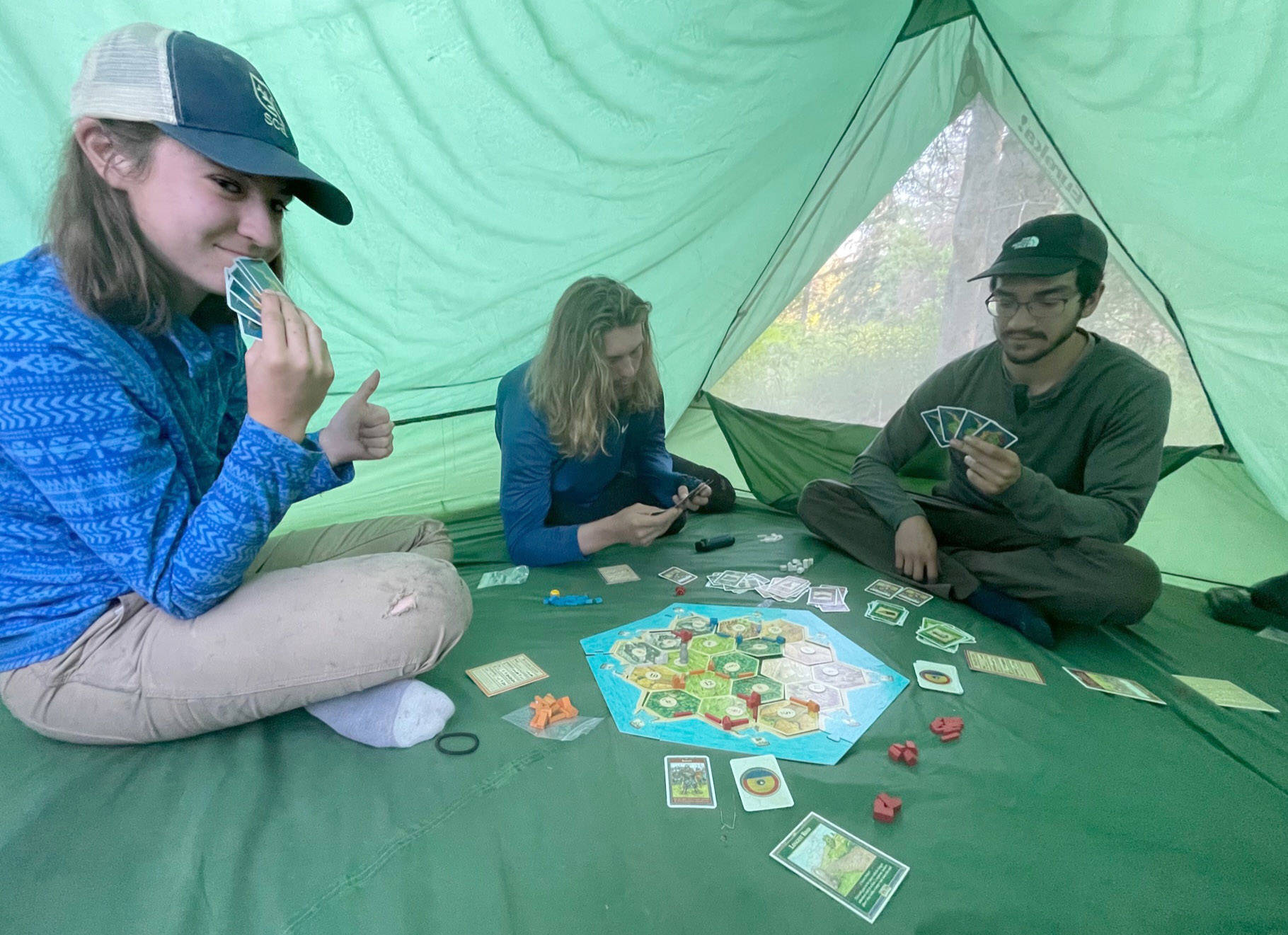By SANJA ZELEN
Kenai National Wildlife Refuge
It was 10 miles out in the backcountry, just off the Kenai National Wildlife Refuge’s Hansen Horse Trail, when I played one of my first games of Catan. After a long hike in, the trail crew and I had unloaded our green tent from the pannier of one of our pack horses, soon to be named “the community tent.” With hasty determination, we laid out the tent, footnote and rainfly. Puzzled, we shook the tent bag again.
“Anyone see the stakes or poles?”
The question floated around the group.
Searching our pile of gear, we came out empty-handed. Chuckling, we got to work doing the only thing we could do in the backcountry: improvise. Paracord was threaded through the pole clips and around two spruces. We shoved spare, rusted stakes in the ground. It was by no means perfect, but we had ourselves a standing tent at the Funny River Campground. Master improvisers.
The other thing about backcountry living is that few truly flat surfaces exist. A log became our countertop for cutting veggies and boiling water. Yellow hard hats balanced sandwiches. Just like the floor of our green tent, slanting drastically, became the playing grounds for Settlers of Catan.
While the community tent was made to fit four people lying down, it became home to five dusty trail crew members and one Catan board. That first evening of our eight-day hitch on the Hansen Horse Trail, we were exhausted, having hiked 10 miles in and eaten big portions of our classic backcountry meal: red sauce pasta.
Still, there were dishes to do, Ursacks to hang (keeping food away from bears), and blisters to mend. The food coma and exhaustion were not going to hinder our competitive spirits, though.
Shortly after the evening’s chores were complete, Catan came out of a plastic bag stuffed in the side pocket of my leader’s pack.
First, we placed 19 octagonal game pieces on the tent floor to form one big, loose game board, sliding downhill every time someone shifted in the tent. Next, circular tiles were placed on top of these, followed by seven decks of Catan cards lining the board’s perimeter. Finally, to top it all off, everyone got small wooden “roads,” “cities” and “settlements,” which they would place on the board with the roll of dice.
We shifted away from the board cautiously at first, the octagons creeping into the folds of the tent. As soon as the dice were handed to the first player, though, we were laughing and trading cards, reaching this way and that as we forgot that this was not the traditional way or place to play Catan.
To thoroughly explain Settlers of Catan to those who have not played before would ruin the surprise. In its essence, the game depends on the roll of two dice and the resources-specific numbers you get — sheep, rock, brick, wheat, or wood. In its essence, Catan is a backcountry haven.
That first night playing Catan marked the beginning of a tradition. Even after working 10 hours on the trail and coming back to unload food from hanging food in Ursacks, cooking dinner on WhisperLite stoves, and washing dishes over a sump hole each day, one brave soul always whispers, “Catan?”
Chewing stops. A heavy silence hangs in the air. A snickered, “Don’t tempt me,” muttered as a joke or possibly just a way to break the tension, always becomes, “Yes.”
As much as playing Catan on the lumpy floor of the community tent in smelly work clothes has become a running joke, having the game out there has taught me lessons about outdoor living. Being in the backcountry for eight days at a time comes with immense challenges. For example, the Hansen Horse Trail has no level footing, blowdowns that require our team days of work to remove, and daily treks across the icy Funny River.
Trail work, like our game of Catan, requires improvisation. To cross the Funny River, we set up a rope to hold onto and ensure safe footing across. The blowdowns have increased our leadership skills, often splitting us into two groups of loppers and sawers and sending us miles apart. Outside of work, we have adjusted the bear fence, protected our gear from rain, and established chores to run camp as smoothly as possible.
Above all, Catan has become a simple joy after a long day in a remote setting. When Wi-Fi and cozy kitchens are removed from the picture, our uneven, borderline dysfunctional Catan board comes to the rescue. No matter how hard our workdays get, there is always at least one person willing to jump in and play a game.
During one of the final days of our first hitch, someone in my group posed a question: “Would you rather start a settlement at the Funny River or on Mars?” At first, we laughed, but then we realized the Hansen Horse Trail gave us more than we imagined. After all, there are no moose, glacial streams or campsites on Mars.
In the end, we have learned that joy can be found in the simplest of things when living in the woods. Regardless of the strenuousness of our workdays, there is no avoiding the victory in a game of Catan. Or major defeat, depending on who is playing. The tables are always turning in our party, even if the table is an uneven green tent floor in the middle of the backcountry.
Sanja Zelen is a member of the SCA Alaska Trail crew working on the Kenai National Wildlife Refuge’s Hansen Horse Trail. After her season ends, she plans on pursuing environmental communications work in Portland, Oregon. Find more Refuge Notebook articles at https://www.fws.gov/refuge/Kenai/community/refuge_notebook.html

